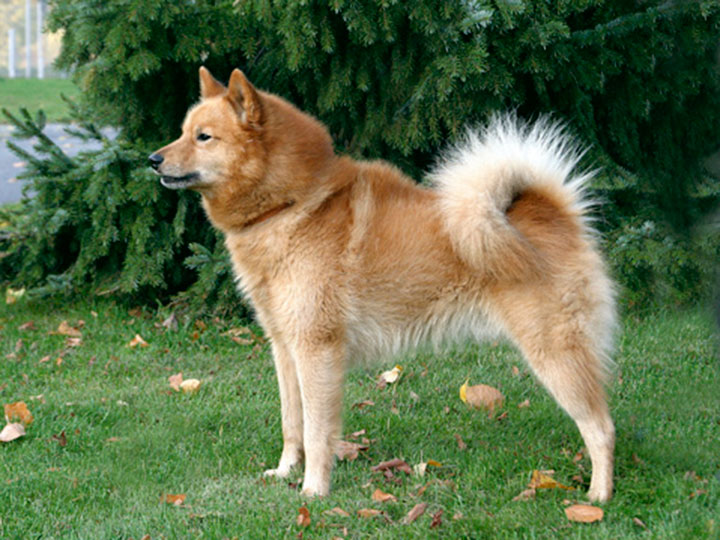The Finnish Spitz (Suomenpystykorva) primarily barks at birds perched in trees, using its voice to indicate the location of game. It is mostly used to hunt forest game birds, but also to some extent as an elk-hunting dog as well as to hunt small game and retrieve birds shot into the water.

When retrieving game, the Finnish Spitz will move over a distance of 100 - 500 metres and often even further away from the hunter. The connection with the hunter will be retained in spite of this distance, however. It finds birds on the ground or in trees with the help of its extremely sensitive nose and is capable of tracking an escaping bird for several hundred metres in even the most difficult terrain. It indicates the location of the bird with its bark and behaviour, and will try to keep the bird in the tree by barking until the hunter gets there.
The harsh fight for survival has left indelible, breed-typical marks in the temperament of the Finnish Spitz. Most common are its speed to react, distrust of strangers, loyalty to its master and family as well as an eagerness to guard its own territory.
By nature, the Finnish Spitz is cooperative, energetic, lively and independent. It may be reserved towards strangers. It enjoys being outdoors, but its powerful hunting instinct rarely make it suitable to be kept as an untethered yard dog. It may get used to living in an apartment building, but its readiness to bark can make it a less-than-optimal choice for people living in built-up areas, especially if they are not experienced dog owners.
History of the Finnish Spitz
19th-century literature contains references to the Finnish Spitz. In 1875, French explorer de la Martiniere wrote of his encounters with dark red dogs in the far north, up to as far as the Murmansk coast. In 1834, Wilhelm von Wright wrote about the similar appearance of the barking bird dog and the fox. In addition to hunting for food, this dog was used to catch animals for their fur. Once a systematic effort to develop the breed commenced, the main emphasis was steered towards bird hunting.
Suomen Kennelklubi, a precursor of the Finnish Kennel Club that was established in 1889, decided that its first task was to hold a dog show to review the status of the Finnish barking bird dog and hound dog breeds. Landrace Spitzes that look like the present-day Finnish Spitz were exhibited at the show. In 1892, a “Finnish barking bird dog” was added to the organisation's pedigree book.
Breed characteristics drafted by master forester Hugo Richard Sandberg were approved for this dog. A new breed definition was confirmed in 1897, when the name of the breed was also changed to the Finnish Spitz. The breed definition was next revised in 1925 and the most recent changes were approved in 1996.
It is fair to say that the Finnish Spitz has been an established breed since the 1930s. It was declared Finland's national dog breed in 1979. The Finnish Spitz is a valuable aspect of the vibrant Finnish cultural heritage and it is closely linked to the history of the Finnish people. It can, with good reason, be considered a national treasure and the effort to nurture its population is valuable cultural work.
Finnish Kennel Club registration statistics indicate that the Finnish Spitz population, which develops in tandem with the game bird population with a slight lag, has decreased somewhat over the last decade. In 1994, 1,459 individuals were registered, while there were 834 registrations in 2004. Registrations peaked during the abundant fowl years of the 1960s, with a record 2,866 Finnish Spitzes registered in 1968.
Appearance and size
The Finnish Spitz is smaller than average and has a square, solid structure and good posture. Its ears are erect and mobile. The eyes are mid-sized, almond shaped, slightly slanted and dark. The nose is always black. Its starting speed is explosive when necessary and it moves with effortless lightness. Its entire appearance and expression is one of vibrant attentiveness.
A male's ideal height at the withers is 47 cm (lower limit 44 cm and upper limit 50 cm). For females, the corresponding figure is 42 cm (lower limit 39 cm and upper limit 45 cm).
The Finnish Spitz is yellowish or reddish brown in colour. The colour is usually bright. It is adorned with attractive lighter hair in the back thighs and some times in the shape of reins on the sides, in addition to which the inner arch of the tail is light. The tail wags when it is barking at a bird and it will charm the target to remain in the tree. The tail coils tightly forward along the back starting from the stem and down to the side, reaching as low as the back hairs of the thigh.
Breed registration statistics
Below you can find the registration statistics for the Finnish Spitz in the Nordic countries from 1990 onwards.
| | Finland | Denmark | Iceland | Norway | Sweden |
|---|
| 2015 |
624 |
3 |
0 |
39 |
183 |
|---|
| 2010 |
599 |
0 |
0 |
52 |
266 |
|---|
| 2005 |
762 |
0 |
0 |
40 |
363 |
|---|
| 2000 |
846 |
3 |
0 |
11 |
319 |
|---|
| 1995 |
1198 |
6 |
0 |
23 |
430 |
|---|
| 1990 |
1721 |
7 |
0 |
43 |
629 |
|---|
NKU decisions regarding the Finnish Spitz
Next to each decision is a reference to the meeting minutes from which the information is collected.
| 2-2006, Item 17 |
Information that the Finnish Kennel Club and RKF have signed an agreement regarding registration of the Finnish-Carelian Laika as Finnish Spitz. |